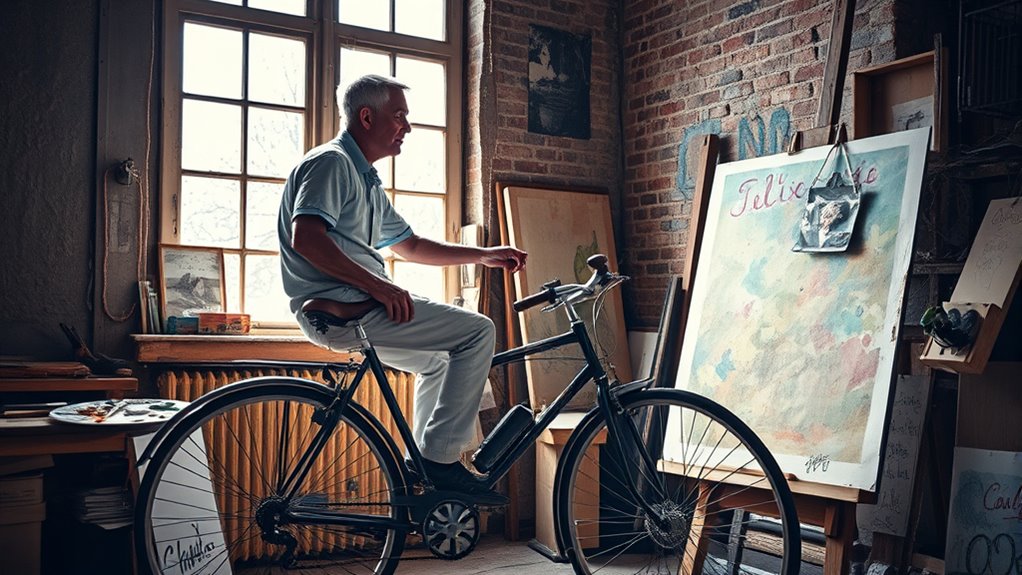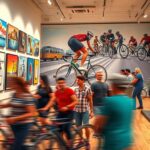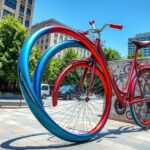Many renowned artists, like Marcel Duchamp, inspired by cycling’s modernity, transformed everyday objects into conceptual art. Impressionists such as Warren Keating captured cycling’s energy with loose brushwork, while Jean Metzinger depicted speed through fragmented forms. Contemporary creatives like Ai Weiwei use bicycles to explore themes of mass production and social change. If you look further, you’ll discover how cycling has shaped art movements and inspired generations of artists across history.
Key Takeaways
- Marcel Duchamp transformed a bicycle into a seminal work of conceptual art with his 1913 piece *Bicycle Wheel*.
- Jean Metzinger’s cycle-race paintings employed fragmented forms to depict speed and modernity inspired by cycling.
- Toulouse-Lautrec’s posters and urban scenes promoted cycling’s social and gender progress during the Belle Époque.
- Modernist artists like Elie Nadelman incorporated folk art styles into their cycling-inspired artworks, blending tradition and innovation.
- Contemporary artists such as Ai Weiwei use bicycles in installations to comment on mass production, interconnectedness, and social themes.
Early 20th Century Modernist Pioneers
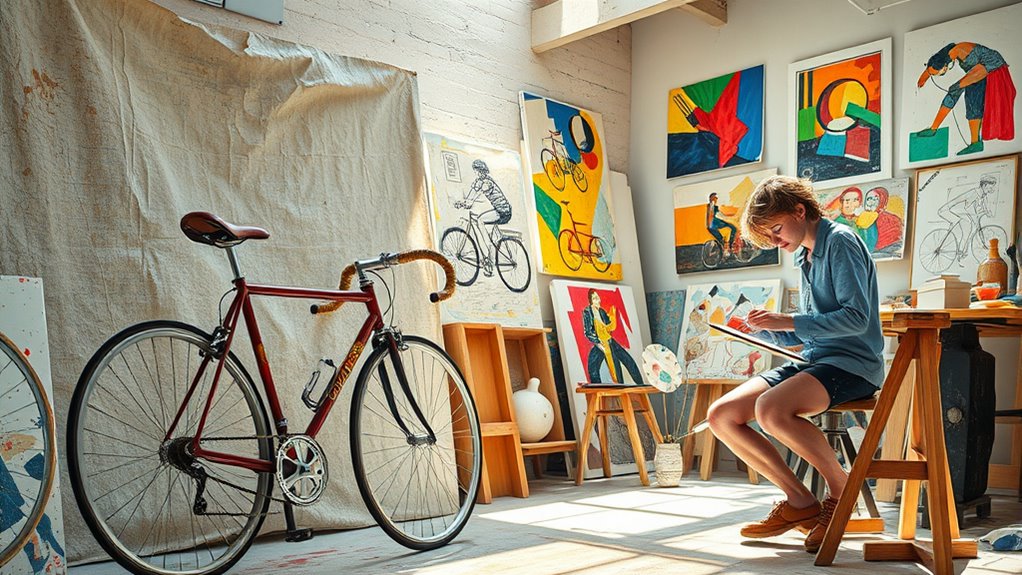
Early 20th-century modernist pioneers embraced cycling not just as transportation but as a source of artistic inspiration and experimentation. Marcel Duchamp’s 1913 *Bicycle Wheel* exemplifies this, transforming a simple bicycle wheel into art by mounting it on a stool. This piece challenged traditional notions of art, emphasizing conceptual ideas over craftsmanship.
It influenced Dada and Surrealist movements, highlighting the importance of everyday objects in artistic discourse. Writers like T.S. Eliot, Wyndham Lewis, and Samuel Beckett also found cycling essential for their creativity, viewing it as a way to clear their minds and find new perspectives.
Cycling symbolized resilience amid modern chaos and became a metaphor for motion in literature. These pioneers used cycling to push boundaries, blending art, literature, and personal experience into revolutionary expressions.
Impressionist and Post-Impressionist Perspectives
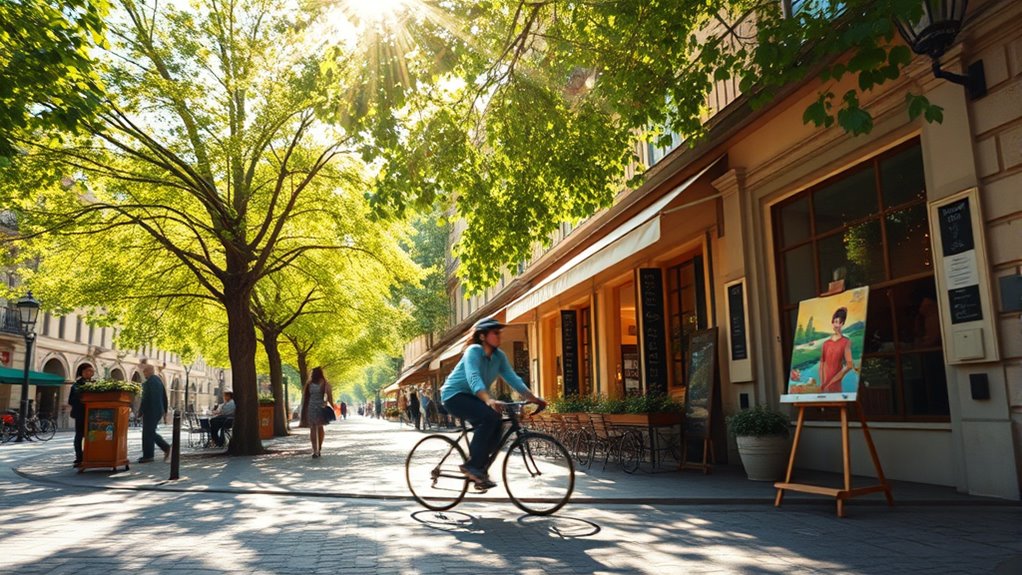
Have you ever noticed how cycling scenes burst with vibrant energy and movement in Impressionist and Post-Impressionist art? Artists like Warren Keating capture this dynamism with loose brushwork and light effects, portraying cycling in deserted landscapes. Artists often incorporated bike components, highlighting the technological innovations that influenced artistic representations of cycling. Jean Metzinger’s cycle-race paintings use fragmented forms to emphasize speed and motion, reflecting their fascination with modernity. Impressionists celebrated outdoor leisure activities, aligning cycling with bourgeois leisure during the Industrial Revolution. Post-Impressionists pushed boundaries further, experimenting with bold colors, flattened perspectives, and layered compositions inspired by rhythmic motion. Toulouse-Lautrec promoted cycling’s social and gender progress through striking posters, while urban scenes integrated bicycles to symbolize societal shifts. These artists celebrated cycling as a symbol of modern life, capturing movement, innovation, and changing social roles. Additionally, the influence of sound vibrations from sound healing science can be seen in the rhythmic and layered compositions that evoke the sensation of motion and energy. Exploring visual rhythm can deepen our understanding of how these artworks convey energy and flow, emphasizing the importance of artistic experimentation in capturing the spirit of modernity.
The Influence of Belle Époque and Modern Progress

The Belle Époque era ignited a cycling boom that deeply influenced contemporary art, reflecting society’s embrace of modernity and social liberation. As bicycles became symbols of progress, artists captured their energy through fragmented forms and vibrant colors, like Jean Metzinger’s *At the Cycle-Race Track*. Cycling represented urban mobility and industrialization, often intertwined with women’s emancipation, appearing in artworks that celebrated newfound freedom. Technological advancements in bicycles, such as mechanization and materials like tubular steel, inspired artists to explore motion, gears, and engineering aesthetics. Public races and cycling clubs became symbols of social change, depicted as microcosms of modern society. Cubist and Futurist techniques conveyed speed and dynamism, translating cycling’s kinetic energy into bold geometric and abstract forms that resonate in modern art’s evolution. Additionally, the development of color accuracy in art materials allowed artists to depict the vibrant hues of cycling scenes more realistically, enhancing their expressive impact. The depiction of motion and speed in artworks was further amplified by innovations in artistic techniques, reflecting the rapid pace of technological progress during the era, and the influence of modern artistic movements that embraced innovation and experimentation.
Artists Merging Folk Art and Modernism

Artists embracing modernism increasingly turned to Folk Art as a source of inspiration, blending traditional, untrained styles with innovative techniques. You see this in the way they incorporated folk forms like weathervanes, decoys, and hooked rugs into modernist works, creating a fresh visual language. The use of Self Watering Plant Pots as a metaphor for sustainable and self-sufficient artistic practices also reflects this blending of old and new. Figures like Elie Nadelman and Yasuo Kuniyoshi explored abstract and straightforward forms rooted in Folk Art, challenging academic conventions. Museums and curators actively promoted this fusion, showcasing Folk Art alongside modernist pieces to highlight its influence. The raw, untrained aesthetic inspired Surrealists like André Breton and helped break artistic boundaries. Folk Art’s cultural significance and creative spirit offered a powerful alternative to traditional techniques, shaping a new, expressive direction in modern art that continues to resonate today. Additionally, the movement’s emphasis on authenticity and cultural expression helped redefine artistic innovation, especially as it intersected with contemporary cultural movements. Recognizing the importance of artistic authenticity, many modernists sought to preserve and elevate folk traditions within their innovative practices.
Contemporary Creators Celebrating Cycling Culture
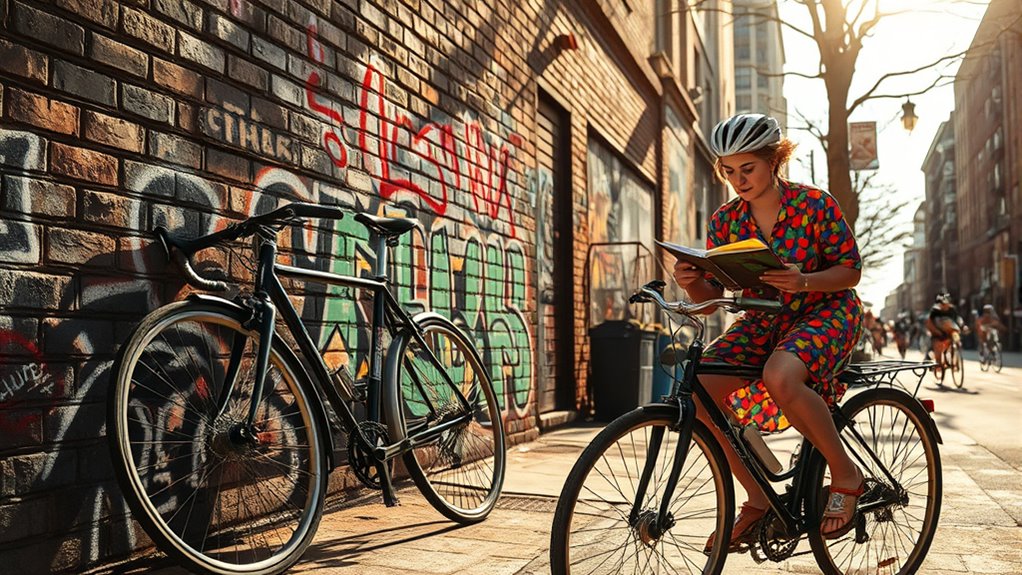
Contemporary creators are harnessing cycling as a powerful motif to explore social themes and urban culture. Ai Weiwei uses bicycles in installations like “Forever Bicycles” to comment on mass production and modern life’s interconnectedness. Artists also incorporate espionage symbolism in their work, subtly reflecting themes of surveillance and clandestine communication. Grayson Perry weaves cycling into his art, blending personal stories with societal observations. Gil Bruvel’s sculptures, such as “The Cyclist,” capture the joy and energy of riding. Bari Kumar explores human-powered transportation through rickshaw-themed videos, emphasizing resilience and community. Street artists frequently depict bicycles in murals, symbolizing freedom and urban identity. These artists highlight eco-consciousness, social mobility, and the collective spirit of cycling. Their work sparks conversations around urban mobility, sustainability, accessibility, and the role of bikes in shaping contemporary urban life. Additionally, some artists explore the psychological impact of cycling, illustrating its influence on mental well-being and personal growth. The use of jet boats as a symbol of adventure and exploration can also serve as a metaphor for the dynamic and innovative spirit of cycling culture. Furthermore, recent trends show how artistic representations of cycling are evolving to address climate change and environmental activism, inspiring viewers to consider sustainable transportation options.
Cycling in Commercial and Public Art Installations

Cycling has become a prominent motif in public and commercial art installations, transforming urban spaces and promotional campaigns alike. You’ll see this in Ai Weiwei’s “Forever Bicycle,” where 720 stacked bicycles create an optical illusion, symbolizing sustainability in Abu Dhabi.
Across the UK, Millennium Mileposts cast in iron stand along the National Cycle Network, celebrating freedom and diversity. In natural settings, EuroVelo Land Art integrates artworks with cycling routes, connecting riders to nature. Incorporating visual symbolism enhances the narrative and emotional impact of these artworks. The use of urban infrastructure as art further emphasizes cycling’s integration into daily life. Additionally, these installations often utilize public space to engage communities and encourage interaction. The rise of Remote Hackathons has also inspired innovative digital art projects centered around cycling themes, expanding creative possibilities.
Cities like Chattanooga blend public art with cycling infrastructure, enriching community experiences. Commercially, cycling influences product design, marketing, and branding—companies sponsor events and use cycling imagery to promote themes like health and adventure.
These installations and campaigns elevate cycling’s role, making it a powerful symbol in urban and commercial landscapes. Security systems and surveillance technologies also increasingly incorporate cycling themes, reflecting their popularity in contemporary art and design.
Art Movements Embracing the Speed and Mechanics of Cycling
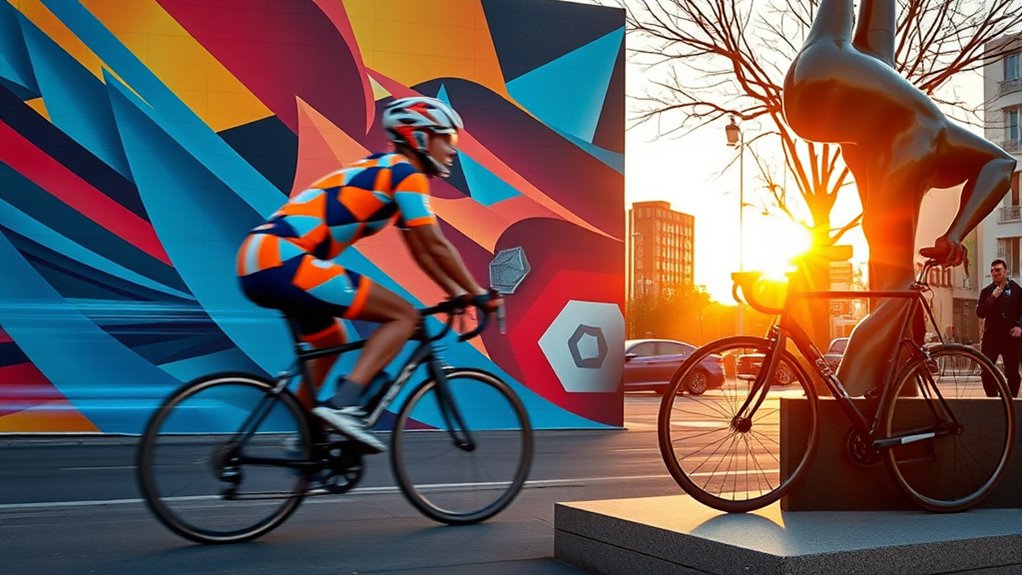
The allure of speed and mechanization drew art movements like Impressionism, Cubism, and Futurism to explore cycling as a symbol of modernity. Impressionists captured cycling scenes, emphasizing motion and energy, with works like Jean Metzinger’s “At the Cycle-Race Track” showcasing the dynamic pace of the sport.
Cubism embraced cycling’s association with speed and mechanization, fragmenting forms to reflect movement and the bicycle’s geometric components, as seen in Boccioni’s “Dynamism of a Cyclist.”
Futurists celebrated the kinetic energy of cycling, emphasizing motion, machinery, and technological progress, often portraying bicycles in abstract, energetic forms. These movements saw cycling as more than sport—they represented the rapid, mechanized world shaping modern life, inspiring artists to explore speed, space, and the machine age.
Cycling as a Symbol of Societal Change and Liberation
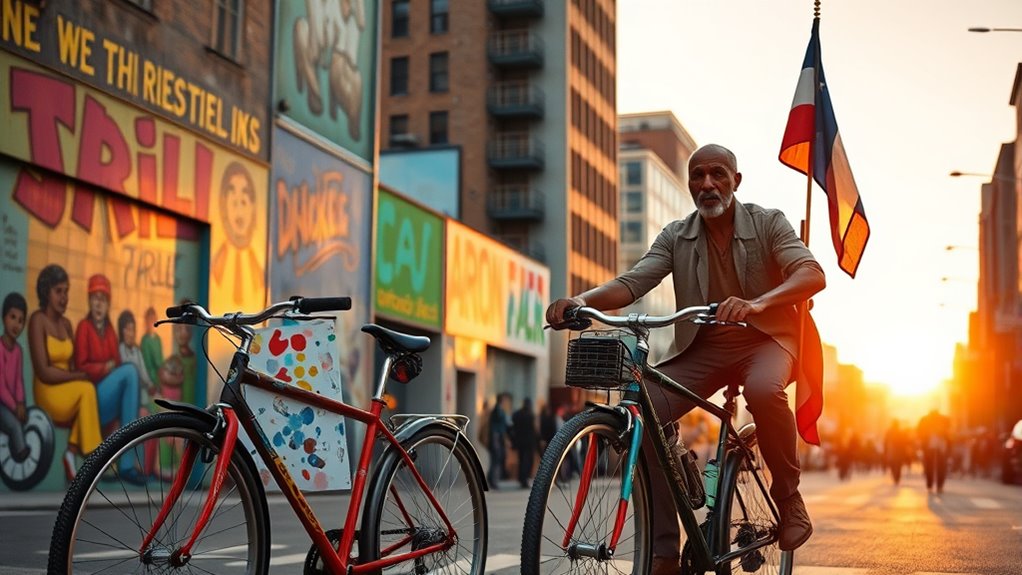
Throughout history, bicycles have served as powerful symbols of societal change and liberation, enabling marginalized groups to challenge existing norms and expand their freedoms. You see this in the late 19th century, when women used bikes to travel independently, defying Victorian gender restrictions. Practical clothing like bloomers replaced restrictive corsets, symbolizing bodily autonomy.
Cycling also opened doors for women to participate in education and work, fostering early feminist movements. Artists like Toulouse-Lautrec captured women’s joy while cycling, emphasizing defiance and independence.
Today, women in Karachi organize cycling collectives to reclaim public space despite harassment. Bicycles have consistently empowered the working class, promoting equality by reducing reliance on costly transportation.
Modern Artists Addressing Climate and Urban Mobility
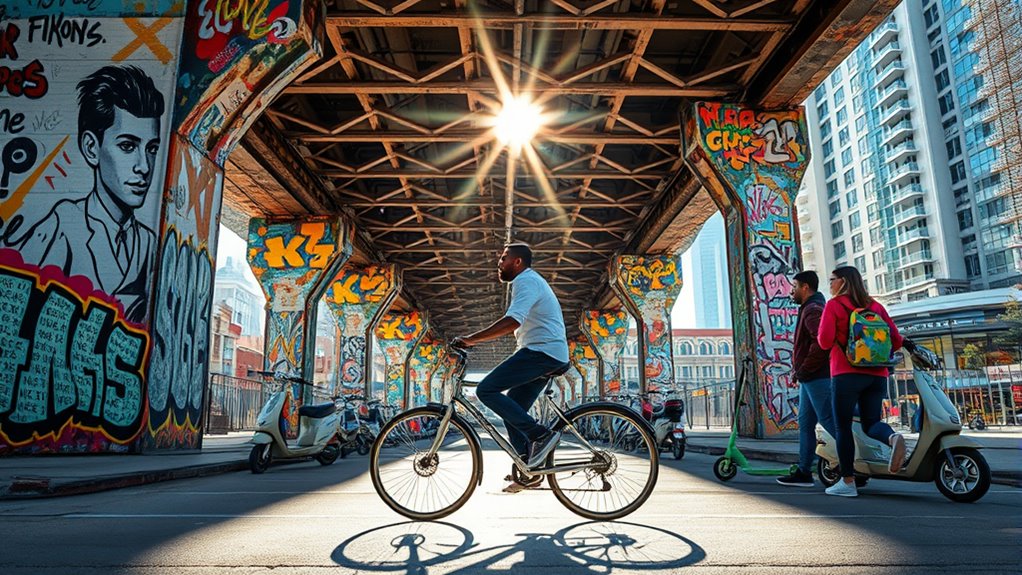
Modern artists are increasingly exploring themes of climate change and urban mobility through their work, highlighting cycling’s role in sustainable transportation and city life. Ondřej Kohout uses sarcastic humor in paintings like *Mouse Loving Cyclist*, critiquing cyclist-car interactions.
Karel Štědrý employs abstract mandala-inspired techniques, representing movement and energy efficiency. Taliah Lempert captures NYC’s bike culture with vibrant, figurative geometric compositions, advocating for human-powered transport.
Ai Weiwei’s bicycle sculptures merge industrial materials with social commentary on mass production and consumerism. Michael Valenti designs vintage posters celebrating global cycling culture and races, indirectly promoting eco-friendly urban mobility.
These artists underscore cycling’s importance in addressing climate challenges and shaping sustainable cities, inspiring viewers to contemplate cycling as an essential part of urban life and environmental responsibility.
Frequently Asked Questions
How Did Cycling Influence the Development of Abstract Art Techniques?
Cycling influences the development of abstract art techniques by inspiring a sense of movement and energy. As you ride through changing landscapes and experience dynamic terrains, you notice how colors, textures, and forms shift rapidly.
This encourages you to experiment with bold, spontaneous brushstrokes and layered textures. The emotional intensity of cycling—joy, challenge, freedom—also fuels your desire to capture motion and emotion, shaping your abstract expressions.
Which Artists Used Cycling Themes to Challenge Traditional Artistic Norms?
Think of cycling themes as a paintbrush breaking through a canvas of tradition. You see, artists like Roy Lichtenstein and Ai Weiwei used bicycles to challenge old norms—pop art’s bright colors and mass production critiques, or sculptures that engage public spaces.
You can find cycling imagery in murals, contemporary paintings, and installations, all pushing boundaries and showing how art evolves when it pedals beyond conventional limits.
How Has Cycling Been Depicted Differently Across Various Global Art Cultures?
You see that across diverse cultures, cycling gets depicted in unique ways. In European modernism, artists emphasize motion and speed with geometric or fragmented forms.
In contemporary global art, bicycles symbolize resistance, sustainability, or resilience, often merging social messages with visual styles. You notice how different societies use bicycles to reflect identity, progress, or social issues, showing that the art of cycling varies widely, shaped by local histories, cultures, and values.
What Role Does Cycling Play in Contemporary Street Art and Graffiti?
In contemporary street art and graffiti, cycling symbolizes mobility, freedom, and sustainability. You see bikes used as allegories for community and environmental activism, often integrated into murals to promote eco-friendly policies.
Artists also leverage cycling for stealth and transport, making it essential for large-scale projects. Through vibrant designs and innovative techniques, cycling enhances urban narratives, connecting art, activism, and city life in dynamic, engaging ways.
Are There Any Notable Sculptures or Public Artworks Featuring Cycling Themes?
You’ll find many notable sculptures and public artworks centered around cycling themes. For example, Ai Weiwei’s bicycle installation with 1,200 bicycles comments on mobility and societal change.
Public art near race tracks and bike trails highlights cycling’s dynamic and communal aspects. Kinetic sculptures mimic bike motion, adding interactivity.
Communities often create collaborative projects, and cycling-inspired sculptures are integrated into urban architecture, celebrating movement, modernity, and social engagement through art.
Conclusion
As you step back and see the vibrant tapestry of artists inspired by cycling, remember that each stroke and sculpture captures more than motion — it embodies freedom, progress, and change racing through time. Like a wheel turning endlessly forward, their creations remind us that art and cycling both propel society toward new horizons. Embrace this artful journey, where every pedal and brushstroke sparks a revolution of imagination and transformation.
